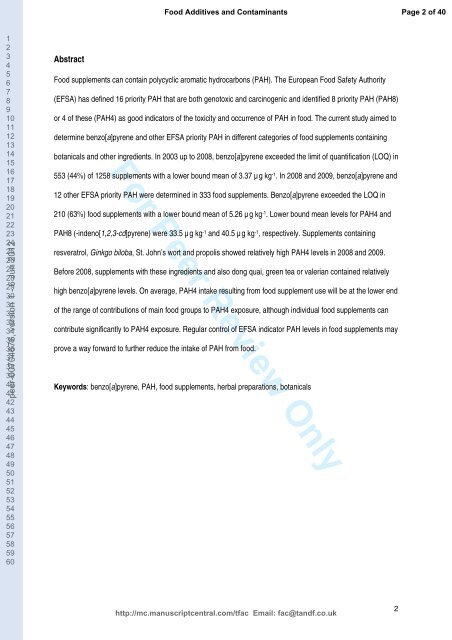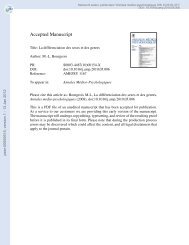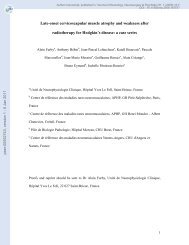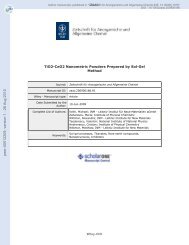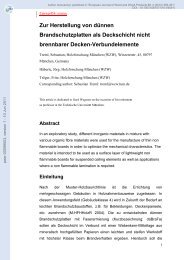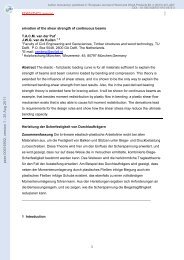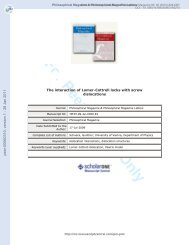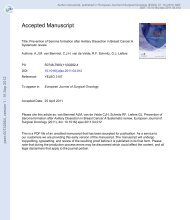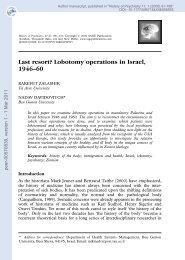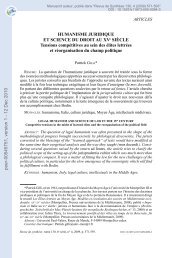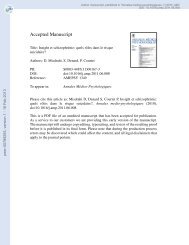Monitoring of Polycyclic Aromatic Hydrocarbons (PAH) in food ...
Monitoring of Polycyclic Aromatic Hydrocarbons (PAH) in food ...
Monitoring of Polycyclic Aromatic Hydrocarbons (PAH) in food ...
You also want an ePaper? Increase the reach of your titles
YUMPU automatically turns print PDFs into web optimized ePapers that Google loves.
1<br />
2<br />
3<br />
4<br />
5<br />
6<br />
7<br />
8<br />
9<br />
10<br />
11<br />
12<br />
13<br />
14<br />
15<br />
16<br />
17<br />
18<br />
19<br />
20<br />
21<br />
22<br />
23<br />
24<br />
25<br />
26<br />
27<br />
28<br />
29<br />
30<br />
31<br />
32<br />
33<br />
34<br />
35<br />
36<br />
37<br />
38<br />
39<br />
40<br />
peer-00704676, version 1 - 6 Jun 2012<br />
41<br />
42<br />
43<br />
44<br />
45<br />
46<br />
47<br />
48<br />
49<br />
50<br />
51<br />
52<br />
53<br />
54<br />
55<br />
56<br />
57<br />
58<br />
59<br />
60<br />
Abstract<br />
Food Additives and Contam<strong>in</strong>ants<br />
Food supplements can conta<strong>in</strong> polycyclic aromatic hydrocarbons (<strong>PAH</strong>). The European Food Safety Authority<br />
(EFSA) has def<strong>in</strong>ed 16 priority <strong>PAH</strong> that are both genotoxic and carc<strong>in</strong>ogenic and identified 8 priority <strong>PAH</strong> (<strong>PAH</strong>8)<br />
or 4 <strong>of</strong> these (<strong>PAH</strong>4) as good <strong>in</strong>dicators <strong>of</strong> the toxicity and occurrence <strong>of</strong> <strong>PAH</strong> <strong>in</strong> <strong>food</strong>. The current study aimed to<br />
determ<strong>in</strong>e benzo[a]pyrene and other EFSA priority <strong>PAH</strong> <strong>in</strong> different categories <strong>of</strong> <strong>food</strong> supplements conta<strong>in</strong><strong>in</strong>g<br />
botanicals and other <strong>in</strong>gredients. In 2003 up to 2008, benzo[a]pyrene exceeded the limit <strong>of</strong> quantification (LOQ) <strong>in</strong><br />
For Peer Review Only<br />
553 (44%) <strong>of</strong> 1258 supplements with a lower bound mean <strong>of</strong> 3.37 µ g kg -1 . In 2008 and 2009, benzo[a]pyrene and<br />
12 other EFSA priority <strong>PAH</strong> were determ<strong>in</strong>ed <strong>in</strong> 333 <strong>food</strong> supplements. Benzo[a]pyrene exceeded the LOQ <strong>in</strong><br />
210 (63%) <strong>food</strong> supplements with a lower bound mean <strong>of</strong> 5.26 µ g kg -1 . Lower bound mean levels for <strong>PAH</strong>4 and<br />
<strong>PAH</strong>8 (-<strong>in</strong>deno[1,2,3-cd]pyrene) were 33.5 µg kg -1 and 40.5 µ g kg -1 , respectively. Supplements conta<strong>in</strong><strong>in</strong>g<br />
resveratrol, G<strong>in</strong>kgo biloba, St. John’s wort and propolis showed relatively high <strong>PAH</strong>4 levels <strong>in</strong> 2008 and 2009.<br />
Before 2008, supplements with these <strong>in</strong>gredients and also dong quai, green tea or valerian conta<strong>in</strong>ed relatively<br />
high benzo[a]pyrene levels. On average, <strong>PAH</strong>4 <strong>in</strong>take result<strong>in</strong>g from <strong>food</strong> supplement use will be at the lower end<br />
<strong>of</strong> the range <strong>of</strong> contributions <strong>of</strong> ma<strong>in</strong> <strong>food</strong> groups to <strong>PAH</strong>4 exposure, although <strong>in</strong>dividual <strong>food</strong> supplements can<br />
contribute significantly to <strong>PAH</strong>4 exposure. Regular control <strong>of</strong> EFSA <strong>in</strong>dicator <strong>PAH</strong> levels <strong>in</strong> <strong>food</strong> supplements may<br />
prove a way forward to further reduce the <strong>in</strong>take <strong>of</strong> <strong>PAH</strong> from <strong>food</strong>.<br />
Keywords: benzo[a]pyrene, <strong>PAH</strong>, <strong>food</strong> supplements, herbal preparations, botanicals<br />
http://mc.manuscriptcentral.com/tfac Email: fac@tandf.co.uk<br />
2<br />
Page 2 <strong>of</strong> 40


